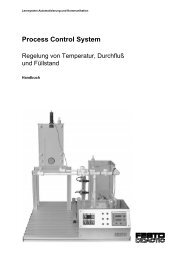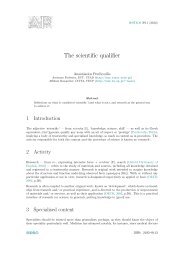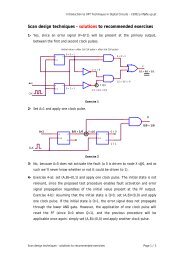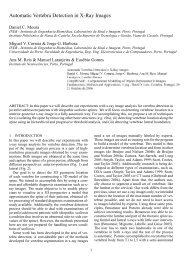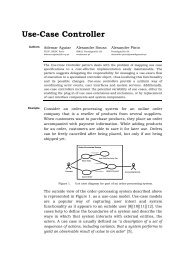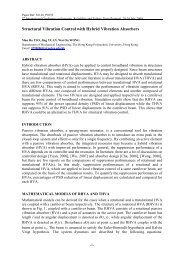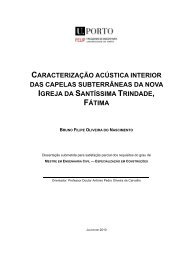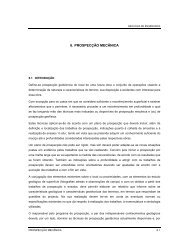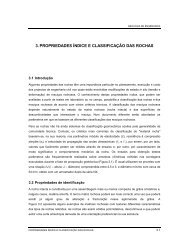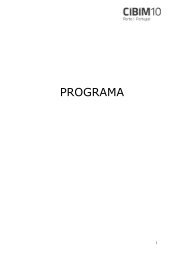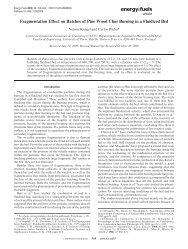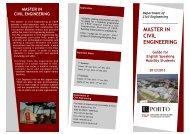Bio-inspired multi-agent systems for reconfigurable manufacturing ...
Bio-inspired multi-agent systems for reconfigurable manufacturing ...
Bio-inspired multi-agent systems for reconfigurable manufacturing ...
You also want an ePaper? Increase the reach of your titles
YUMPU automatically turns print PDFs into web optimized ePapers that Google loves.
936<br />
P. Leit~ao et al. / Engineering Applications of Artificial Intelligence 25 (2012) 934–944<br />
there will be several trips to the same source. The optimal solution<br />
(i.e., the shortest one) will be the trail that has more intense<br />
pheromones. After a while, gradually, the trails that have less intense<br />
pheromones are abandoned by the ants because the pheromones are<br />
not rein<strong>for</strong>ced. Naturally, these trails are no longer considered as<br />
options. Sometimes, ants can walk randomly instead of choosing a<br />
pheromone trail, which is a good way to find new paths that have<br />
appeared in the mean time (Bonabeau et al., 1997).<br />
The double-bridge experiment conducted by Deneubourg et al.<br />
(1990) rein<strong>for</strong>ces the idea that ants can indeed find the shortest<br />
paths to goals. In their experiments, if two equal paths from the<br />
nest to a food source, each path is chosen 50% of the time; in each<br />
experiment, the ants tend to choose only one path. On the other<br />
hand, if one path is significantly longer than the other, the ants<br />
chose the shortest one (Goss et al., 1989).<br />
Another illustrative example of indirect communication supporting<br />
swarm intelligence is related to the waggle dance used by<br />
honey bees to share in<strong>for</strong>mation about the direction and distance<br />
to patches of flowers yielding nectar and pollen. After scouting an<br />
area <strong>for</strong> a food source, honey bees return to the hive and in<strong>for</strong>m<br />
other bees about the food source, per<strong>for</strong>ming a dance known as<br />
the ‘‘waggle dance’’, as shown in Fig. 1b. This dance provides the<br />
following in<strong>for</strong>mation to the other bees: (1) the rotation angle of<br />
the dance, in relation to the sun, states the direction in which the<br />
food source can be found and (2) the duration of the dance<br />
represents the travel distance to the food source (Bonabeau et al.,<br />
1999; Frisch, 1967). Other researchers suggest that this dance also<br />
provides a third kind of in<strong>for</strong>mation related to the quality and<br />
quantity of the food source. This last in<strong>for</strong>mation is shared by<br />
releasing a pheromone-type odor (Dornhaus et al., 2003).<br />
Swarm intelligence can be achieved more from coordinating<br />
activities of individuals and less from using decision-making<br />
mechanisms. A well-known example is the movement of flock<br />
of birds (e.g., the typical V <strong>for</strong>mation), where individuals coordinate<br />
their movements in relation to the movement of the others<br />
(Reynolds, 1987). For this purpose, simple mechanisms are used<br />
to coordinate the individual behavior: feedback mechanisms,<br />
which use positive and negative feedback to regulate the system’s<br />
behavior (Camazine et al., 2002):<br />
(i) in positive feedback, the system responds to the perturbation<br />
in the same direction as the change (i.e., towards the amplification<br />
of the perturbation); and<br />
(ii) in negative feedback, the system responds to the perturbation<br />
in the opposite direction (i.e., towards the stabilization of the<br />
perturbation).<br />
By combining both positive and negative feedback, the system<br />
can be maintained under control but pushed to its limits<br />
(Camazine et al., 2002). For example, the simple rule ‘‘I nest where<br />
other similar individuals nest unless there are too many fishes’’<br />
(Camazine et al., 2002), used to describe fish nesting, combines<br />
positive and negative feedback: the first part uses positive feedback,<br />
allowing the aggregation of fishes in the same place to be<br />
increased, and the second part uses negative feedback, thus<br />
avoiding a high concentration of fishes in the same place. Other<br />
similar coordination mechanisms are found in other areas of<br />
science and nature, namely market laws (Markus et al., 1996)<br />
and potential fields (Vaario and Ueda, 1996), based on regulating<br />
the expectations of individuals with conflicts of interest.<br />
2.2. Evolution and self-organization<br />
The Darwinian theory of evolution is a <strong>for</strong>m of adaptation to<br />
dynamic environmental evolution. Darwin stated that nature is in<br />
a permanent trans<strong>for</strong>mative state in which the species would<br />
change from generation to generation, evolving to better suit their<br />
environment. Basically, Darwin saw the evolution as a result of<br />
environmental selection acting on a population of organisms<br />
competing <strong>for</strong> resources. In this evolutionary process, the selection<br />
is natural in the sense that it is purely spontaneous without a<br />
pre-defined plan. In other words, species tend to evolve to<br />
overcome their limitations and to adapt to external natural<br />
conditions. For example, a species can per<strong>for</strong>m small spontaneous<br />
changes within their chromosomes, which provokes some physiological<br />
changes after a few generations.<br />
Self-organization is another <strong>for</strong>m of adaptation to dynamic<br />
environmental evolution. Several distinct, not necessarily contradictory,<br />
definitions can be found in the literature (Massotte, 1995;<br />
Bousbia and Trentesaux, 2002; Tharumarajah, 1998). However,<br />
the definition used in this paper is: ‘‘The ability of an entity/system<br />
to adapt dynamically its behavior to external changing conditions<br />
without external intervention’’ (Leit~ao, 2008b). Self-organizing<br />
<strong>systems</strong> do not follow an approximate, rigid organization, but<br />
instead evolve through a dynamic, non-linear process with a<br />
constant optimization of the individuals’ behavior.<br />
Examples of self-organization can be found in several domains:<br />
Physics—In thermodynamics, the 2nd law states that everything<br />
in the universe tends to move from a state of order<br />
towards a state of chaos (introducing the concept of entropy),<br />
which explains that hot bodies tend to get colder with an<br />
external cold source (e.g., a refrigerator). Another example is<br />
found on the Bénard rolls phenomenon in which the hot and<br />
cold molecules self-organize themselves in order to create<br />
a flow.<br />
Chemistry—For example, molecules exhibit self-assembly properties,<br />
which drive the molecular structure to self-organization<br />
(Whitesides et al., 1991). Another example is the Belousov–<br />
Zhabotinsky chemical oscillator, which is composed of a reaction<br />
sequence that <strong>for</strong>ms a loop (Shanks, 2001).<br />
Nature—The stigmergy phenomenon is used to achieve sel<strong>for</strong>ganization<br />
in ant colonies.<br />
The coordination mechanisms found in colonies of ants and<br />
bees, besides allowing members of these species to communicate,<br />
allow the whole community to achieve and display self-organization<br />
behavior. Bonabeau et al. (1997) suggest that the basic<br />
ingredients to achieve a self-organized system are positive feedback,<br />
negative feedback and fluctuations (e.g., random walks and<br />
errors). They also suggest that self-organization relies on the<br />
<strong>multi</strong>ple interactions between the individuals.<br />
3. Survey of bio-<strong>inspired</strong> applications <strong>for</strong> solving complex<br />
problems<br />
Several researchers used biological behavior (e.g., colonies of<br />
insects) to solve complex mathematical engineering problems. In<br />
this section, bio-<strong>inspired</strong> techniques and methods in engineering<br />
are briefly reviewed, with special attention to their applicability<br />
in <strong>manufacturing</strong>.<br />
3.1. Applied to mathematical engineering problems<br />
The insights inherited from the swarm intelligence principles<br />
led researchers to design optimization evolutionary algorithms:<br />
Ant Colony Optimization (ACO), the Artificial Bee Colony (ABC)<br />
Algorithm and Particle Swarm Optimization (PSO).<br />
Dorigo (1992) introduced the Ant Colony Optimization (ACO)<br />
technique, <strong>inspired</strong> by the food <strong>for</strong>aging behavior of ants, to solve<br />
problems that need to find optimal paths to some goal. In ACO,



